New Orleans, the largest metropolitan area in the state of Louisiana, is known by many names, such as “The Crescent City,” “The Big Easy” and “The City That Care Forgot” — a moniker used since 1938 to express the carefree nature of the residents. However, it took on an ironic connotation in the post-Hurricane Katrina era.
My favorite of its many nicknames is “The City of the Dead,” a reference to its many cemeteries boasting above-ground crypts and mausoleums so closely situated that they take on the look of small communities. My wife and I recently visited two such graveyards and they do, indeed, look like quiet little villages. Very quiet.
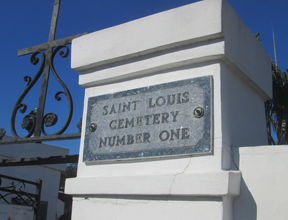 Saint Louis Cemetery Number 1, which dates back to 1789, is located at the corner of St. Louis and Basin Streets, just outside the famed French Quarter. The Archdiocese of New Orleans presides over several cemeteries within the city, giving them imaginative names like St. Joseph Cemetery Number 1, St. Joseph Cemetery Number 2, St. Patrick Cemetery Number 1, St. Patrick Cemetery Number 2, St. Patrick Cemetery Number 3 and two more in the Saint Louis group (guess what they’re called?). Surrounded by a high stone wall, Saint Louis Cemetery Number 1 takes up one small city block. Inside, it is jammed with haphazardly placed crypts. There is no discernible pathway through the cemetery. Walkways are blocked by mausoleums that seem to have popped up out of nowhere.
Saint Louis Cemetery Number 1, which dates back to 1789, is located at the corner of St. Louis and Basin Streets, just outside the famed French Quarter. The Archdiocese of New Orleans presides over several cemeteries within the city, giving them imaginative names like St. Joseph Cemetery Number 1, St. Joseph Cemetery Number 2, St. Patrick Cemetery Number 1, St. Patrick Cemetery Number 2, St. Patrick Cemetery Number 3 and two more in the Saint Louis group (guess what they’re called?). Surrounded by a high stone wall, Saint Louis Cemetery Number 1 takes up one small city block. Inside, it is jammed with haphazardly placed crypts. There is no discernible pathway through the cemetery. Walkways are blocked by mausoleums that seem to have popped up out of nowhere.
As of March 2015, the Roman Catholic Diocese of New Orleans, which owns and manages Saint Louis Cemetery Number 1, has closed it to the general public, because of the rise in vandalism to crypts and monuments, as well as numerous assaults in around around the cemetery grounds. Access is now only available with an authorized tour guide.
Inside the surrounding walls, there is a lot of this…
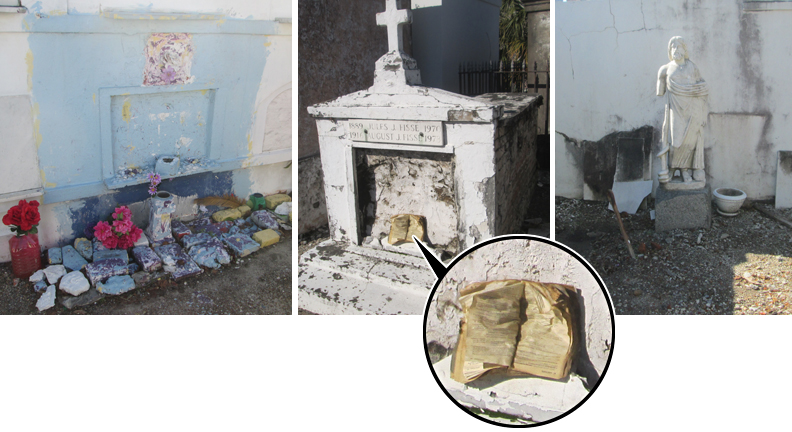
and there’s a lot of this…

Crumbling crypts, possibly neglected in the aftermath of Hurricane Katrina, but, most likely, just victims of age and indifference.
There’s also lot of these…
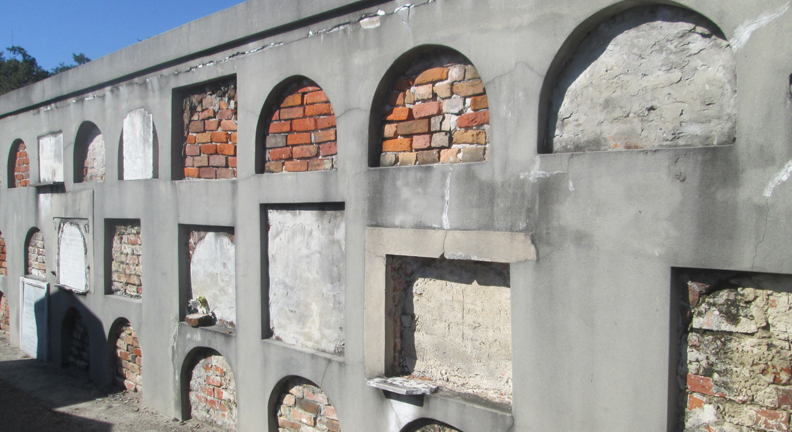 …known as “oven crypts,” because of their similarity in style and shape to brick ovens. Some are so old that records of the contents have been lost to time.
…known as “oven crypts,” because of their similarity in style and shape to brick ovens. Some are so old that records of the contents have been lost to time.
Saint Louis Cemetery Number 1 is the disputed final resting place of notorious voodoo queen Marie Laveau. A hairdresser by trade, Mme. Laveau was also documented to be a liquor importer. But her real fame came from her alleged magical powers stemming from the mystical potions and talismans that she purveyed.

Mme. Laveau is possibly buried in any one of a number of deteriorating crypts that believers and disciples have marked with red “X”s, defiantly breaking the laws against vandalism futilely enforced by the New Orleans Police. Visitors regularly leave offerings of coins, beads — and sometimes their trash — at the crypts. Warnings from locals claim that the voodoo queen’s spirit still lurks within the cemetery walls. Mme. Laveau was portrayed by Angela Bassett in the anthology series American Horror Story in the Coven season.
The community mausoleum of The Italian Mutual Benevolent Society is the centerpiece of Saint Louis Cemetery Number 1, and it’s the tallest structure in the place. The crypt displays space for 24 bodies. A year after burial, the remaining bones of a corpse are placed in a room in the basement with other, older bones to make room for new burials. I swear!
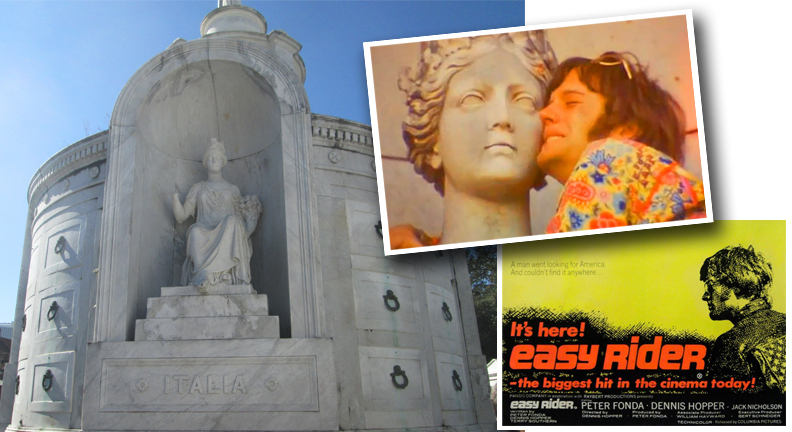
A climactic scene in the film Easy Rider was filmed in and around the cemetery, culminating with a fantasy sequence involving Peter Fonda’s “Captain America” character (on an acid trip) interacting with a statue that adorns this monument.
Opposite the Italia crypt is an out-of-place cement pyramid that is the future eternal resting space of actor Nicolas Cage.

When the monument was erected in 2010, locals expressed their displeasure with the ostentatious construction. In the meantime, only Cage’s career resides inside.
Just inside the entrance of the cemetery is the crypt of Alexander “Buddy” Anspecker.
He was the caretaker of Saint Louis Cemetery Number 1 for forty-one years, prior to his death in 1984. After seeing the current state of the grounds, Mr. Anspecker’s services are sorely missed.
 Twenty minutes north, but still within the New Orleans city limits, is the sprawling Metairie Cemetery. The grounds were originally occupied by Metairie Horse Race Track, which was owned and operated by the Metairie Jockey Club. Local businessman and founder of the Louisiana State Lottery Charles T. Howard was refused membership to the club. A furious Howard decried that the race course would one day become a cemetery. After the Civil War, the track went bankrupt and, sure enough, the grounds were sold for a cemetery. Howard’s grave is located on a prime spot on Central Avenue in Metairie Cemetery. A map of the grounds shows that the plotting of the grave lots still maintains the oval shape and layout of the race track.
Twenty minutes north, but still within the New Orleans city limits, is the sprawling Metairie Cemetery. The grounds were originally occupied by Metairie Horse Race Track, which was owned and operated by the Metairie Jockey Club. Local businessman and founder of the Louisiana State Lottery Charles T. Howard was refused membership to the club. A furious Howard decried that the race course would one day become a cemetery. After the Civil War, the track went bankrupt and, sure enough, the grounds were sold for a cemetery. Howard’s grave is located on a prime spot on Central Avenue in Metairie Cemetery. A map of the grounds shows that the plotting of the grave lots still maintains the oval shape and layout of the race track.
Metairie Cemetery is the eternal home of over 30,000 residents, including the All Saints Mausoleum which houses the cremated remains of loved ones in over 1900 glass-fronted niches, and a pet cemetery on the grounds. The entrance, on Pontchartrain Boulevard, opens to a section affectionately called “Millionaire’s Row,” and for good reason. These folks were loaded when they walked the earth. The first mausoleum that we came across is that of restaurateur (and colorful local legend) Al Copeland.
Al was the founder of the popular Popeye’s Fried Chicken chain. In addition, he started two namesake chain restaurants as well as a trendy Brazilian steakhouse. In 1993, after losing a bid for a casino gambling license, Copeland got into a fistfight at a Morton’s Steakhouse with Robert Guidry, who was awarded the license. Author Anne Rice, a proud and outspoken New Orleans resident (more on that later), publicly criticized Copeland’s opening of a restaurant in a run-down area of New Orleans, calling the move “nothing short of an abomination.”
Near Copeland’s grave is the polished marble mausoleum of Ruth Fertel.
In 1965, hoping to make money to send her sons to college, Ruth purchased the 60-seat Chris’ Steak House in New Orleans from an ad in the newspaper. On her first day in business, she sold 35 steaks. Within six months, she doubled her previous annual salary as a lab technician. After ten years, the restaurant suffered extensive damage from a fire. She reopened in a new location, but the original sales agreement prevented her from using the “Chris'” name at the new address. She renamed the place “Ruth’s Chris’ Steak House.” Over the next two decades, Ruth franchised her successful establishment across the country and across the world.
Next to Ruth is poet and artist Stan Rice, husband of author Anne Rice.
Inspired by the leukemia death of daughter Michelle in 1972, Stan published a book of poetry called Some Lamb dealing with illness and death. He encouraged his wife, Anne, to quit her job as a waitress and devote her time to writing as a vocation. She went on to write 35 novels, including the Interview with the Vampire series. (Anne passed away in 2021 and will be interred here, as well.)
Traveling through the landscaped plots, we found the small crypt of wild bandleader and trumpet player Louis Prima.
Louis, best known for his songs “Just A Gigolo,” “Jump, Jive ‘n’ Wail,” and “That Old Black Magic,” also wrote the classic big-band epic “Sing Sing Sing.” In the 60s, he provided the voice for King Louie in Disney’s animated The Jungle Book. He was famous for his raucous lounge shows in Las Vegas with cohorts Keely Smith and saxophonist Sam Butera and The Witnesses. Louis developed a brain tumor in 1973. After surgery, he lapsed into a coma for three years until his death in 1978. His crypt is appropriately topped with a figure of the angel Gabriel blowing a trumpet.
Prima’s grave backs up to several rows of wall crypts, typical for New Orleans cemeteries, but unusual in Metairie, where single graves and mausoleums are the norm.

A few sections over is the in-ground plot of Sam Zemurray.
Although his name may not be familiar, Sam revolutionized the banana import business. In a story that reads like an action-packed swashbuckler, Zemurray was involved in military coups and overthrowing foreign governments in order to grow his business. He eventually became the head of the United Fruit Company, the forerunner to present-day Chiquita Brands International, the leading distributor of bananas in the United States. Sam’s harrowing life story is chronicled in the book The Fish that Ate the Whale. I highly recommend it.
In the middle of a nondescript row is the unassuming crypt of actress Dorothy Dell.
Although she only appeared in four films, she garnered comparisons to Mae West. Dorothy had a hit song with “With My Eyes Wide Open, I’m Dreaming” in 1934. She starred with Shirley Temple in Little Miss Marker. Dorothy, who was only 19, was killed in a car accident while returning home after a night of drinking.
Making our way to the front section, we passed some of the beautiful and unusual sculptures that decorate many of the graves at Metairie.

There’s a representation of a faithful dog waiting for his master and a weeping woman at the entrance to gambler J.V. Harrington’s crypt. The Brunswig pyramid is one of Metairie’s most famous, as are the bronze children at the elaborate Vonderbank Family mausoleum.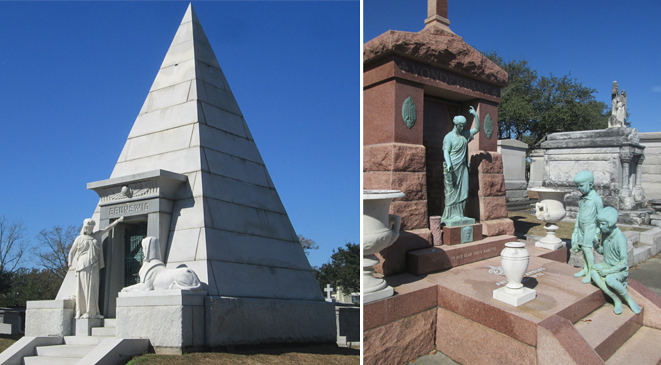
One of the most storied graves at Metairie is that of New Orleans madam Josie Arlington.
Josie practiced her trade in Storyville, New Orleans’ infamous red light district, named after its legislating Alderman Stanley Story. Story designated a sixteen block section in which prostitution and drugs were “not illegal,” as long as it was kept within the boundaries. Josie operated a very successful brothel in the area, offering patrons the services of ten girls and a “sex circus” that was available for an additional fee. Her crypt features a full-size bronze figure seemingly knocking on the door, said to symbolize Josie’s assertion that “no virgin was ever defiled or exploited by her business.” Local legend claims that the figure leaves its post and wanders the grounds. Humiliated that Josie’s grave was a tourist attraction (but not that their relative was a prostitute), Josie’s family had her body moved to an undisclosed grave elsewhere in the cemetery. The Morales family purchased the crypt and their deceased were buried within.
A little further down is the Greek Temple-styled mausoleum of stockbroker and philanthropist Chapman H. Hyams.
Behind the locked doors is a beautiful, yet startling, copy of William Wetmore Story’s statue “Angel of Grief.” which Chapman commissioned as a tribute to his sisters. The figure, lit by natural sunlight through blue stained glass, is simultaneously stunning and creepy. I took the side-view photo with my camera up against the padlocked front door. I managed the overhead shot through a hole that, sadly, someone had broken in the stained glass.
Standing near the big two-level “Metairie Cemetery” sign is the crypt of baseball great Mel Ott.
Mel, a 12-time All-star, played twenty-two seasons, all with the New York Giants. He led the Giants in home runs for 18 consecutive seasons, a record that remains unbroken. Mel’s unorthodox batting style of lifting up his lead leg before swinging was adopted Kirby Puckett, Harold Baines and Japanese home run king Sadaharu Oh, As a manager, Mel’s easy-going demeanor proved unsuccessful, prompting successor Leo Durocher to make his often-quoted statement: “Nice guys finish last.”
Death is not limited to New Orleans’ cemeteries. In 1991, Johnny Thunders, guitarist and founding member of punk pioneers The New York Dolls, was found dead in room 37 of the Inn on St.Peter’s on the edge of the French Quarter.
Johnny’s room was ransacked and a number of his possessions were missing, including his passport and clothing. His body was found under a coffee table, twisted into an unnatural position. An autopsy revealed a non-fatal amount of drugs in his system, although evidence of advanced leukemia was documented.
In the days after Hurricane Katrina, Barry Cowsill was found dead beneath the Governor Nicholls Street Wharf at St. Phillips Street near the waterfront French Market.
Barry gained fame in the 1960s as the bass player in his family band, appropriately named The Cowsills. They had pop hits with “The Rain, The Park and Other Things,” “Indian Lake,” and “Hair” from the Broadway musical. The band was the inspiration for The Partridge Family TV show and were originally recruited to star. Barry lived and performed frequently in New Orleans. He left a cryptic and upsetting message on his sister Susan’s answering machine during the hurricane. His death was attributed to drowning.
Also after Hurricane Katrina, rock and roll groundbreaker Fats Domino was incorrectly reported dead by an act of vandalism on his home.

Fats is alive and was merely staying with relatives to brave the storm. His home, in the Ninth Ward, was salvaged, rebuilt and he still lives there. (Note: Fats Domino passed away on October 24, 2017.)
The LaLaurie Mansion is an infamous landmark on Royal Street.
It was the home of socialite Delphine LaLaurie. Stories of torture and other depravities, including severe and relentless beatings of slaves, surrounded the home and the LaLaurie Family. The mansion has continually been reported as being haunted. In later years, actor Nicolas Cage purchased the mansion until foreclosure brought it back to market. It is currently unoccupied. The LaLaurie Mansion was the setting of the third season of American Horror Story (the same season that featured Marie Laveau). A heavily fictionalized version of Delphine LaLaurie was portrayed by Academy Award-winning actress Kathy Bates.
Speaking of haunting, the famed Absinthe House is also the location of supposed ghost sightings.
General Andrew Jackson allegedly met with pirate Jean Lafitte at this location to discuss plans for the Battle of New Orleans, the final battle of the War of 1812. Patrons claim to see the ghosts of Jackson and Lafitte regularly, but keep in mind that this place is a bar.
At 830 St. Louis Street stands a house that, according to the song, has been the ruin of many a poor boy.
This iron-balconied house is one of many addresses in New Orleans that claim to be the actual “House of the Rising Sun” made famous in the song by The Animals, among others. Each building presents “definitive” evidence, from published city directories to “rising sun” motifs in the décor.
Author Anne Rice owned and lived at two different address in New Orleans.
The houses, both in the Garden District neighborhood, are fittingly reminiscent of the Haunted Mansion in Disneyland. The buildings, both currently for sale, are said to be haunted. If you can cough up 2.65 million dollars, you can buy one and find out for yourself.
Aside from the cemeteries, New Orleans is an interesting city filled with sights you won’t see anywhere else. Practically everyone carries a tuba where ever they go and they really, really like their hot sauce.

As the locals say: “Laissez les bon temps roulez.” I think that means: “Eat some more King Cake.”


